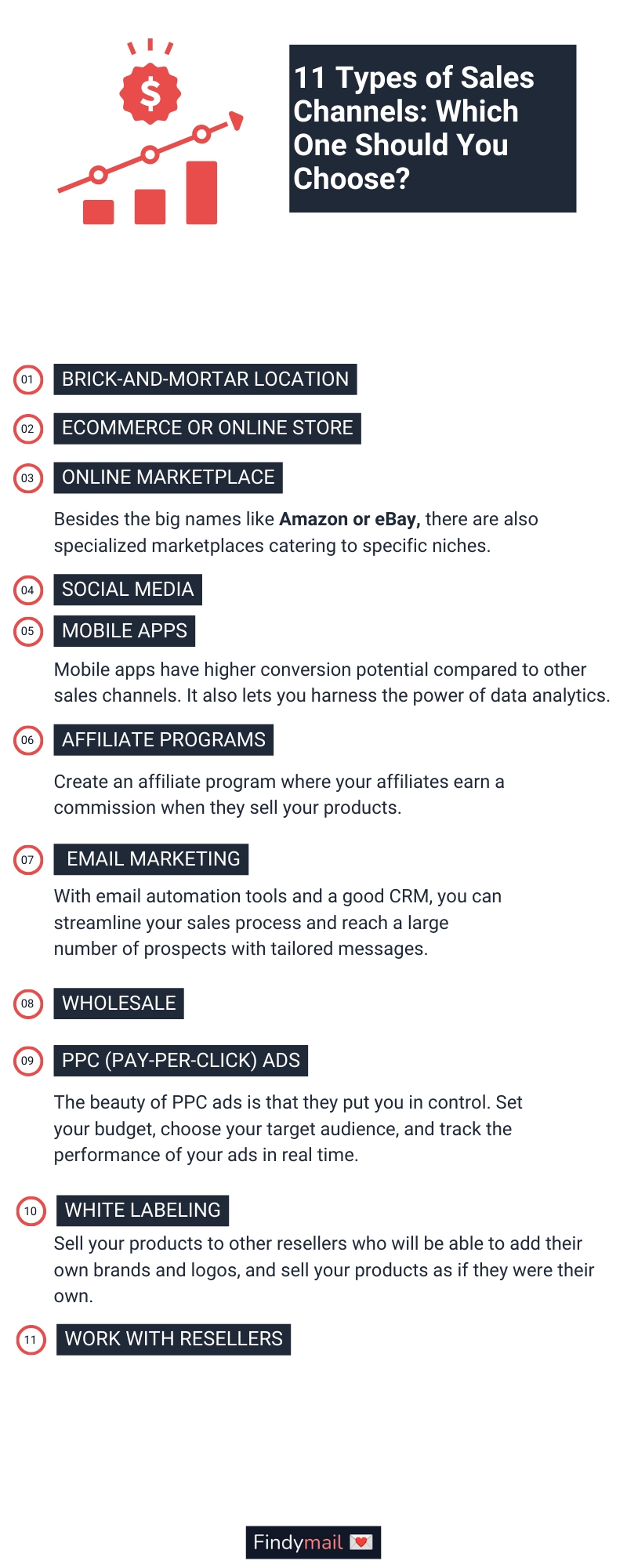Selling your product/service has become more exciting (and a bit overwhelming) than ever before. With a plethora of avenues available at your fingertips, choosing the right sales channel is one of the most important decisions you’ll make.
Trust me, I've been there, too, trying to navigate through the maze of options.
So, in this article, I'll be your guide, walking you through a handpicked selection of the top 11 sales channels.
I’ll explore each channel – highlight its strengths and considerations – and help you figure out which one is best for your business.
Let’s dive in!
What’s a Sales Channel?
A sales channel is essentially the pathway through which you reach your customers and make sales.
It's the route you take to showcase your offerings, communicate with potential buyers, and ultimately convert them into happy customers.
Think of it as the bridge that connects your business to the people who need what you have to offer.
Now, sales channels are not the same as distribution channels. They typically handle the logistics of getting your goods from point A to point B, like shipping and storage.
And you don't have to settle for just one sales channel. You can go all-in with a multichannel approach. That means you can tap into different avenues to connect with your customers.
When you choose your sales channels wisely, they become the backbone of your business strategy. They shape who you target, how you stand out from the competition, how you present your brand to the world, and so much more.
You can deliver a personalized experience in a physical store, make shopping a breeze through an online platform, or connect with them through the buzzing world of social media.
The choice is yours, and it can make all the difference in your success.
Now let’s take a look at all the sales channels you have available.
11 Types of Sales Channels

1) Brick-and-Mortar Location
The classic brick-and-mortar store – a tried and true sales method that we're all familiar with. Picture your favorite retail location down the street, and you've got it.
This sales channel involves having a physical location where customers can come in, browse your products, and make purchases in person.
The beauty of a brick-and-mortar location lies in the opportunity to build closer relationships with your customers.
They can see, touch, and experience your products firsthand, and you can provide them with personalized assistance and recommendations.
And with an online presence, you can complement your physical location with the convenience of online shopping.
For example, if you’re a company that specializes in cutting-edge technology solutions, you can have an online storefront where businesses can explore their extensive product catalog, access detailed specifications, and even place orders conveniently.
However, opening a physical store comes with a bunch of overhead and upfront costs. You've got rent, utilities, inventory management, and staff to consider – just to name a few things.
And since it’s not the most budget-friendly option, most entrepreneurs and startups opt for one of the other sales channels on this list.
2) eCommerce or Online Store
An online store is like a digital shop that uses the internet to open your business up to a global customer base. Today, many brands have an online presence, so you’ve surely seen sites for companies like Nike or Gucci.
Creating an online store involves building a website, securing a domain name, and ensuring smooth functionality. While it requires some technical know-how, user-friendly platforms like Shopify make it easier to set up and manage your online storefront.
But depending on your products, you may need a warehouse for inventory storage and a reliable shipping method to fulfill orders promptly.
Then you have to remember that the competition in the eCommerce space is fierce. To succeed, you'll need to budget for ads and marketing to stand out from the crowd and attract customers to your product or service.
On the bright side, running an online store is more cost-effective than a physical store. You don't have to worry about rent or maintaining a physical space.
3) Online Marketplace
Online marketplaces provide a platform for sellers to showcase their products to a massive customer base. It's like setting up shop in a bustling marketplace where customers flock to discover unique offerings.
Besides the big names like Amazon or eBay, there are also specialized marketplaces catering to specific niches, such as handmade crafts on Etsy or on-demand made-to-order products through sites like Printful and Redbubble.
What's cool about online marketplaces is that they take care of many logistics for you. They handle the website infrastructure, bring in customers, and provide a platform for you to showcase your products.
Of course, you can combine this method and maintain your own store while also leveraging the customer base and visibility of established marketplaces.
Keep in mind, you're still responsible for fulfilling orders and getting the product to the customer. And you’re at their mercy if something goes wrong and they decide to shut down your account.
4) Social Media
Social media isn't just for laughing at cute cats and sharing funny memes – it’s a powerful sales channel at your disposal that can transform the way you connect with customers.
Let’s say you run a B2B company specializing in high-quality office furniture.
A potential client is scrolling through their Facebook feed when they come across a post from your company. The post features a sexy image of a sleek and ergonomic office chair, perfectly designed for modern workplaces.
Intrigued, the client clicks on the chair image and is instantly redirected to the product page on your website. There, they can explore more details, view additional product images, and even make a purchase.
It's a seamless and convenient process that maximizes the likelihood of conversions.
5) Mobile Apps
In a world with around 7 billion smartphone users, it's no surprise that mobile apps have emerged as a popular sales channel.
With their widespread adoption and convenience, mobile apps offer businesses a powerful platform to engage customers and drive sales.
The beauty of mobile apps lies in their ability to provide a convenient and streamlined purchasing process.
Users can easily access your products/services with just a tap on their screens, anytime and anywhere.
Moreover, mobile apps have higher conversion potential compared to other sales channels. Once a user downloads and installs your app, they have already shown a certain level of interest and commitment to your brand.
Mobile apps also let you harness the power of data analytics. By collecting and analyzing user behavior, preferences, and purchase history, you can gain valuable insights to refine your marketing strategies, improve product offerings, and deliver more personalized experiences.
Of course, developing and maintaining a mobile app requires investment and ongoing updates to ensure optimal performance and security.
However, the benefits of increased customer engagement, higher conversion rates, and a direct channel to reach your target audience make it a worthwhile endeavor.
6) Affiliate Programs
Affiliate programs have gained significant popularity as effective sales channels, especially in B2C.
Amazon’s affiliate program is one of the most renowned.
An affiliate is someone who partners with a business to promote their offerings and earns a commission, usually a percentage of any sales they generate.
Typically, these are people with a strong online presence, such as bloggers, YouTubers, or influencers with a substantial following.
For example, you’d reach out to someone that aligns with your brand values and target audience.
They then create content – like a blog post, videos, or social media post – and they’ll feature your product and include unique referral links or discount codes.
When their followers click on those links, make a purchase, and the sale is attributed to the affiliate, they earn a commission.
This incentivizes affiliates to promote your products enthusiastically and provides you with increased visibility, brand exposure, and potential customers.
7) Email Marketing
If you've been following my B2B sales strategy, you know I'm a big fan of sales emails. They are a powerful tool that can drive remarkable marketing ROI, with an average of $36 generated for every $1 spent. It's a no-brainer.
One of the key advantages of sales emails is the ability to automate and personalize your outreach efforts.
With email automation tools and a good CRM, you can streamline your sales process and reach a large number of prospects with tailored messages.
Then throw in some segmentation and personalization, and you got a recipe that can increase engagement and conversion rates.
Sales emails also offer a level of scalability and efficiency that is hard to achieve through other sales channels.
While individual phone calls or in-person meetings may be time-consuming, emails allow you to reach a larger audience in a fraction of the time.
And you can always use templates and other guides to make the process even more efficient.
A resource I recently shared on my LinkedIn. That’s all it takes for a successful email outreach strategy!
8) Wholesale
Wholesale is all about selling large quantities of products to retailers, who then sell them to customers. Stores like Costco and Sam's Club come to mind.
They sell a wide range of products at discounted prices to small business owners or individuals looking to save a bit through bulk purchases.
The cool thing about wholesale is that it lets you tap into established retail channels. By teaming up with retailers, you can get your products in front of a wider audience and boost your brand's visibility.
Another perk is that selling in bulk means lower production costs per unit. That translates to bigger profit margins for your business.
Plus, dealing with larger orders helps you optimize your manufacturing or sourcing processes, saving you time and money.
To dive into wholesale, you'll need to identify your target resellers and present a detailed proposal to their buying department.
This proposal should outline the benefits of carrying your products, including factors like quality, pricing, profit margins, and potential demand.
Building strong partnerships can be extremely lucrative, but it can take time to get there.
9) PPC Ads
PPC (Pay-Per-Click) ads are like modern-day billboards. They are online advertisements where you only pay when someone actually clicks on your ad.
When it comes to PPC, Google Ads is the big boss. It's the largest player in the game, allowing your ads to show on Google Search and YouTube.
But there are other platforms like Facebook that offer a similar service.
On both, you can target specific keywords or interests to reach your ICP. And you can run A/B tests and multiple campaigns to see which approach gets the best results.
The beauty of PPC ads is that they put you in control. You can set your budget, choose your target audience, and track the campaign metrics in real time. It's a flexible and measurable way to drive traffic, generate leads, and boost conversions.
Of course, mastering PPC ads takes some skill and strategic thinking.
You need to research and select the right keywords, craft compelling ad copy, and optimize your campaigns for maximum results.
But once you find that sweet spot, PPC ads can be a powerful tool to supercharge your sales and grow your business.
10) White Labeling
With white labeling, you develop a kick-ass product, but it doesn't carry your brand name.
Instead, you offer it to other businesses that can benefit from using your product in their day-to-day operations or as a solution for their customers.
You’re behind the scenes and focus on the nitty-gritty of designing, manufacturing, and maintaining a product while someone else takes care of the marketing and branding.
To make it work, you need to identify businesses that would be a great fit for your white-labeled product. Think about industries or niches where your product could bring significant value.
Then, develop a compelling sales presentation that showcases how your product can be customized with their brand name and resold to their consumers for a profit.
While the white label offers its fair share of advantages, there is one drawback to consider. Your brand remains in the shadows.
You don't get the recognition or visibility of having your own brand out there.
But if you're more focused on the product itself and less concerned about the limelight, white labeling can be a fantastic opportunity to grow your business.
11) Work with Resellers
When you work with resellers, they become your brand ambassadors, selling your products to their own customers.
The great thing is that they can either sell your product on its own or bundle it with other complementary products they offer. It's a win-win situation where you both benefit.
One popular trend that has emerged in recent years is the rise of subscription boxes. They curate a selection of products from different manufacturers, package them up, and deliver them to customers on a regular basis.
There are subscription boxes for pretty much anything these days!
However, keep in mind that working with resellers requires some legwork on your end. You need to actively seek out potential partners, whether they are retailers, online platforms, or other companies that align with your product.
Reach out to them, pitch your product, and negotiate the terms.
But remember, you won’t have much control over your product once it's with them. And they might not be repeat customers if your product doesn’t sell well for them and only takes up shelf space.
How to Choose the Right Sales Channels
As you can see, there are quite a few sales channels to choose from – so how do you pick the right one?
Here are some things you should consider:
Identify Your Target Customer
First things first, you need to know your targets like the back of your hand:
- What makes them tick?
- Where do they hang out?
- How do they prefer to buy?
By uncovering their preferences and habits through prospecting research, you’ll know which sales channels help you reach them effectively.
Are they tech-savvy and always scrolling through their social media feeds? Or do they prefer the personal touch of a brick-and-mortar store?
Assess Your Competitors
Keep a watchful eye on your competitors and see what they're up to:
- Which sales channels are they using to capture the market?
- Are they rocking it on social media platforms or dominating the online marketplace?
By studying their strategies, you'll not only gain a sense of what's working in your industry but also uncover potential opportunities. Plus, if you spot any channels that your competitors haven't tapped into yet, it could be your chance to shine and capitalize on their oversight.
Morning Brew is a shining example of hopping on the TikTok hype train early, allowing them to leave other newsletters and products biting their dust.
What’s Your Budget?
Your budget plays a significant role in determining the sales channels you can leverage.
Some channels require a substantial financial investment, such as setting up a physical store or investing in advertising campaigns.
Others may be more budget-friendly, like using social media or cold outreach.
It's crucial to evaluate your financial capabilities and choose channels that align with your budget while maximizing the potential return on investment.
So, crunch those numbers, weigh your options, and find the sweet spot where your budget and sales goals meet!
Think about Your Business Model
Are you a B2B superstar or a B2C champ? Maybe you're a hybrid, serving both types of customers. Your business model plays a crucial role in selecting the right sales channels.
Let's say you've developed a groundbreaking automation program designed specifically for a particular industry.
In this case, an eCommerce shop might not be the most effective channel for reaching your target audience. Instead, focusing on email marketing or adopting industry-specific sales approaches could be the way to go.
Consider the nature of your business, your unique value proposition, and how your customers prefer to engage with your products or services.
Take a Multichannel Sales Approach
Let's face it, starting with one channel is totally reasonable, but if you want to expand and make waves, embracing multiple channels is where the magic happens.
Here are some key benefits of adopting a multichannel selling strategy:
- Increased Sales: Who doesn't want more sales, right? By spreading your presence across different channels in your sales strategy, you cast a wider net and reach more potential customers.
- Improved Brand Loyalty: When you offer customers multiple ways to interact with your brand, you're showing them that you're flexible and totally get their preferences. This builds trust and loyalty because, hey, you're making it super convenient for them!
- Better Customer Experience: It's all about making your customers feel like kings and queens. When you offer different channels, you're giving them options. Some folks love the ease of doing everything via email, while others enjoy the personal touch of a sales call.
- Gather More Data: Data is power. With each channel, you can track metrics, analyze trends, and know what's working and what's not. This knowledge gives you the upper hand in refining your marketing strategies and sales methods. Don’t be afraid to use data enrichment tools and B2B contact databases.
- Expanded Reach: Tap into new markets and target different demographics or regions through channels that speak their language. This not only boosts your brand visibility but also attracts new customers who may have never discovered you otherwise.
Taking a multichannel approach empowers your business to leverage the strengths of each sales channel, reaching customers where they are and offering a seamless experience.
Channel Your Business’s Potential!
Now that you know 11 of my favorite sales channels and how to choose which one will be best for you, the only thing left is coming up with your plan and executing it.
I’m a strong proponent of the multichannel approach, but picking one and mastering it isn’t a bad idea either. Just make sure to choose a channel that aligns with your business goals, meets your customers where they are, and has a good ROI.
And if you decide the email sales channel speaks to your soul, don’t forget that Findymail can help take your email game to the next level with legit and verified email addresses at your fingertips.
Sign up today and get your first 10 emails on me!
Take care, sales warriors, and happy selling!






